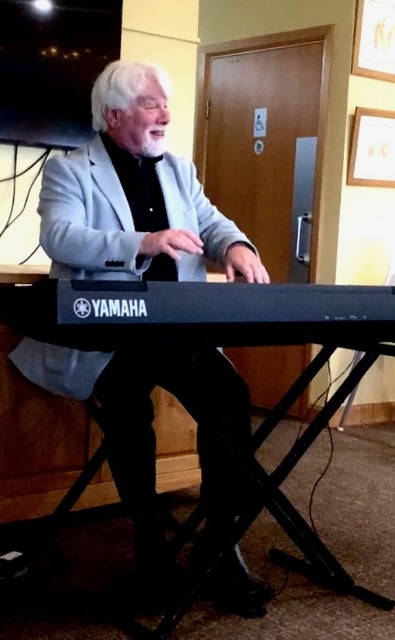Roger Browne entertained us brilliantly once again, this time on the history of jazz and how it came to UK from the United States. His talk was laced with some terrific live piano playing on his own keyboard, mainly blues, ragtime and trad jazz. Born in Blackpool, he taught himself to play the piano by ear during his childhood in Salford, later settling in Stockport. For years he was with the Mart Rodger Manchester Jazz Band and, for a time, with Humphrey Lyttleton. His brand of humour was straight out of Lancashire.
The father of modern jazz Nick LaRocca was born in New Orleans, the son of a Sicilian immigrant. He taught himself to play the cornet after listening to brass bands in New Orleans. His father wanted him to be a lawyer and took an axe to the cornet. Nick saved up for another and practised at school but Dad found and destroyed this one as well. The devil looking after his own, his father died. Nick bought another cornet and he played with Papa Jack Laine’s band from 1910 to 1916, eventually becoming leader of the Original Dixieland Jass Band (note the early spelling). To “jass” in New Orleans meant “to excite or pep up.”
LaRocca (pictured bottom left) played a huge role in popularising jazz, releasing the first ever jazz recording in 1917 of “Livery Stable Blues.” He was the composer of “Tiger Rag,” the most recorded jazz classic of all time. Jazz originated in the Afro-American communities in New Orleans with its roots in blues and ragtime. Ragtime was a huge influence. The blues evolved loosely from spirituals, work-songs, hymns and African chants sung by the slaves in the Mississippi cotton fields around New Orleans. In contrast, ragtime developed within a more conventional structure under classically trained musicians. There were piano competitions in the bars and joints; those playing it faster won the votes, though this turned the unique lilting ragtime rhythm to one of honky-tonk and improvisation. Harry James, a promoter (not to be confused with the band leader of later years), brought the band to Schiller’s Café in Chicago under the name of Stein’s Dixie Jass Band in 1916. They were hugely successful. The Dixieland One Step meant intensity and excitement. Scantily-clad women, rowdiness and drinking into the early hours resulted in police raids and closure. They simply moved down the road to another joint for more money and began again until the next raid.
Nick LaRocca played by ear so new songs were never written down, and copyright was ignored. In the middle of “Livery Stable Blues” he whinnied on his cornet like a horse, a signal for the ladies to pull up their skirts every time. The band, now famous throughout the USA, was brought to New York in 1917 when the band became the Original Dixieland Jass Band before moving on to London. The band changed its name that year to the “Original Dixieland Jazz Band”. The Earl of Donegall, an early jazz fan, introduced the idea to King George V. But its reputation for encouraging rowdy behaviour resulted in a royal performance veto by the Archbishop of Canterbury. Despite this setback, the band was invited to join George Robey’s Joy Bells at the Hippodrome in London for a two-week engagement, in acknowledgement of the American WW1 effort. George Robey reigned supreme in music hall at the time. As soon as news spread across the Atlantic, American fans of the band booked out all available hotel rooms in London, leaving the band with nowhere to sleep other than in the theatre chorus dressing room. George Robey’s English humour fell flat on the Americans until the band came on, when the audience went wild. Up shot the ladies’ skirts as Tiger Rag was played. The band went on to the London Palladium as a stand-alone show and was a huge success. The King went in disguise.
The band was invited a second time to perform at Buckingham Palace in 1919. There was an hour’s wait before the arrival of the court, who were expecting music from the devil himself. There was no chance for an instrument warm up, resulting in a deathly atmosphere until the King cut into half a minute’s silence after Tiger Rag, laughing, clapping and insisting on an encore. The two-week tour lasted 14 months including a repeat visit to Buckingham Palace. The UK tour wasn’t without scandal, with a member of the band having an illicit affair with the daughter of a member of the House of Lords.
Jazz rapidly filtered into the dance band repertoire. Its legacy was a radical change in style of behaviour and dress in the 1920s. Victorian and Edwardian reserve was left behind.
The Original Dixieland Jazz Band broke up in 1925. Nick LaRocca had a breakdown and returned to New Orleans. He retired from music and, while spending time chasing music copyright law suits, perhaps to some extent satisfying his father’s ambition for him to be a lawyer, he finally went into building construction.





